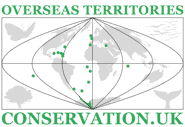Herbarium Training and Knowledge Exchange
While a herbarium is a collection of dead plants, these are collected and preserved with the intention of creating a resource that people can use to help them identify other plants and learn what features are useful in identification. However, there are lots of uses for a herbarium, at least 72, apparently: http://www.virtualherbarium.org/vh/100usesaspt.html.
Herbaria contain plants that are dried and pressed flat, then mounted on paper with labels that describe their name, and the details of who collected them, when and where. But herbaria can also hold seeds and fruits in containers, basically anything that might be useful to identify plants or to be used in research.
In July 2022, Sofie Meeus and Quentin Groom from Meise Botanic Garden in Belgium worked with the Montserrat National Trust and the Department of Environment (as part of the Blue Iguana to Blue Vervain project) to see how Montserrat could build its own herbarium and use it to support conservation and biodiversity monitoring on the island. One of the important themes of the herbarium will be a reference collection to the herbs and bush used in traditional medicine on the island.
As part of the project a workshop was held on herbarium management and specimen mounting at Montserrat National Trust. Together, we mounted about 50 specimens. These included a variety of species. Some were native plants, such as Canella winterana (pepper cinnamon). Some were medicinal plants, such as Stachytarpheta jamaicensis (blue vervain), while others were weeds, such as Synedrella nodiflora (nodeweed). Perhaps one day Montserrat’s herbarium will hold specimens of all of the plants that occur, and hopefully it can be used as much as possible to support conservation efforts. Montserrat does not have a flora to help people identify plants, so meanwhile the herbarium can really help, but perhaps one day the herbarium can help someone write a flora of the island.
